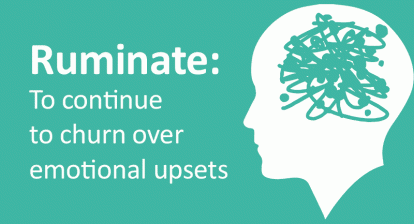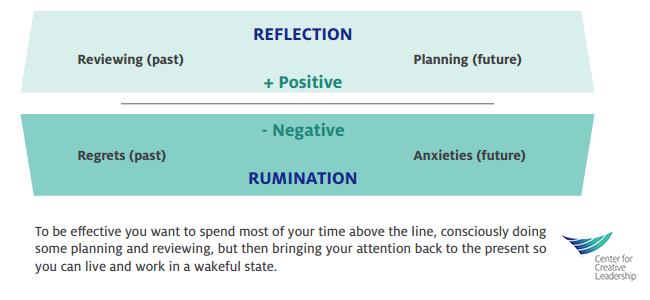How to Banish Stress and Burnout by Stopping Rumination
Ever wonder why different people respond to tough events in different ways? Why some people seem to be more resilient in the face of stress and burnout than others?
As we follow news of the coronavirus pandemic devastating cities around our world, many of us are consumed with fear and worry. We’re finding it hard to sleep and tough to concentrate. How we respond often depends on our unique backgrounds and our communities.
When it comes to general anxiety, stress, and burnout, more than 35 years of research point to one clear difference in our ability to be resilient during hardships: our tendency to ruminate.
What’s Rumination?
 Rumination is the tendency to continue to churn over emotional upsets, and it’s a key determinant of whether you become stressed or not.
Rumination is the tendency to continue to churn over emotional upsets, and it’s a key determinant of whether you become stressed or not.
Rumination is what you do when you wake up at 3 a.m. and can’t get back to sleep because you’re thinking about how many months you’ll have to simultaneously home-school your children and work from home. It’s the kind of thinking that happens when you spiral into worst-case scenarios about your aging parents.
Rumination is what happens when you leave a meeting where you stumbled through your presentation and you can’t stop thinking about what you should have said. Or your mind wanders to past events or future scenarios, replaying worry and negative thoughts over and over.
In short, rumination is the mental process of thinking over and over about something and attaching negative emotions to it. And there’s nothing useful about rumination. It just creates stress symptoms and is the enemy of resilience.
People who don’t ruminate may have plenty of pressure or hardships in their lives, but they aren’t stressed by it.

To feel better, live better, and lead better, you need to find a way to stop ruminating and help your teams and direct reports do the same.
How to Banish Stress and Burnout: 4 Habits to Build Your Resilience & Stop Rumination
Try these 4 mental habits, outlined in our white paper, to increase your resilience and reduce rumination.
4 Ways to Reduce Stress & Burnout
1. Wake up.
To reduce stress and burnout, you need to recognize how much time you spend ruminating. People spend as much as 70% of their daytime hours in a half-awake state, on autopilot or daydreaming. This is where rumination takes place and stress is generated.
The alternative? Wake up, practice mindful leadership, and focus on where you are and what you are doing in the present moment. Don’t let your mind drift into worrying about the past or the future. As the mind develops new habits, you’ll ruminate less often.
2. Control your attention.
People often feel stressed about their lack of control. The one thing you always have control over is your attention. Once you have woken up, you can use and direct your attention. Practice consciously putting your attention where you want it to be and holding it there. Reduce distractions when you’re “in the zone” — working on what matters most, thinking strategically, or being singularly productive.
3. Detach.
Detachment is the ability to maintain perspective. Get appropriate distance from the situations you’re facing. A lack of detachment and the tendency to ruminate are intertwined in a spiral of leadership stress.
When you experience rumination, things balloon out of proportion, and when things are out of proportion, you’re more likely to ruminate and reach burnout. If you can detach from the situations you’re facing, you can distinguish between care and worry. It allows you to reflect and plan, and as we like to say at CCL, burn bright — instead of burning out.
4. Let go.
To maintain perspective, you need to let go. But that doesn’t mean doing nothing or letting go of the work, tasks, or effort. What you let go of are the negative emotions that have become entangled with your situation or issue. Ask yourself a simple question: Will continuing to focus on this help me, my people, or my organization? If the answer is no, let it go. It isn’t doing you any good.
Of course, because of the strength of habit, negative and worrying thoughts will return. When they do, instead of blocking them out or fixating on them, observe and acknowledge them as just thoughts, and let go of them by not continuing to feed them with attention.
Access Our Webinar!
Watch our webinar, How to Promote Wellbeing at Work, and learn how to build a workplace culture that supports and promotes wellbeing for all employees.
Change Your Habits: Stress-Reducing Tactics to Try
How do you banish stress and put these ideas into practice, especially at work? Here are a few tactics to try on your own and as you lead others to reduce burnout:
- Interrupt a pattern. If you catch yourself starting to ruminate, stop. Stand up. Clap your hands once. Stretch in your chair. Do something to get back into your body and out of your head. If you’re in a meeting or other space where you’re constrained, just move in a small way and focus on the movement for a moment. Rub your finger and thumb together, wiggle your toes in your shoes, or move your tongue around your mouth.
- Re-focus on something you can control. People who don’t experience rumination do this naturally, saying, why worry about things I can do nothing about? Think about what is in your circle of control. You can literally draw a circle and write down things you can control inside the circle, then write things you have no influence or control over outside of the circle. Give attention only to what you can control and leave the rest.
- Put things in perspective. Play with scale or time. What’s the problem or challenge that’s happening now? Shrink it down relative to other things you’ve experienced or stretch out in time: How much will this matter in 12 months?
- Get above it all. Imagine your mind as a simple house: one large room with two doors, one at each end, and a loft above. Picture a flood of water on one side of the house, kept out by the door on that side. The flood represents everything we might think about, all of which carry an emotional charge, usually along a continuum from positive to negative. To be aware of a thought, it has to be brought in through the door. Rather than either blocking out the thoughts or drowning in rumination, open a front and back door, and put yourself permanently in the loft. The flood will always be there; resilience comes when you let it pass below you. Being in the loft is what detachment means: being able to step back and see things for what they are without becoming involved in them. You’re not denying the thoughts, but neither are you entertaining them with attention.

Dive deeper into 8 practices that keep you healthy, focused, and functioning with our book, Resilience That Works: Eight Practices for Leadership and Life.
- Connect with your senses. What can you hear, see, feel, taste, and smell? Try this: For 30 seconds, listen to the sounds that are close to you and then the quieter ones in the background. Notice the weight of your feet on the floor, the temperature on your face, and the shapes and colors that are around you right now. Do this several times in the next few days, and notice how it changes the quality of your presence.
- Wake up the people around you. Most workplaces are full of people wandering around on autopilot, resulting in mindless meetings, inauthentic interactions, and a lack of real progress. When you see people going through the motions in meetings, wake them up, not in a way that would embarrass them, but by asking the group provocative questions, such as, “What’s the conversation you should be having right now, but are avoiding?” People wake up, come back into the moment with their colleagues, and the energy level rises.
- Ask direct reports questions about right now. Many people in workplaces suffer over things that are not actually happening. They’re engaging in rumination and imagining the worst possible outcomes. They’re ruminating. When you see people, particularly your direct reports, caught up in the future like this, you can help short-circuit their thinking. Don’t dismiss their feelings, but bring the conversation to the question, “What problem are you experiencing, right now?” This offers something actual and practical that you and they can work on directly.
- Start doing walk-and-talk meetings. People often get stuck talking about the same problem over and over, without moving to a solution. One of the most effective ways to break this pattern is to go for a walk and talk. Just 5 to 10 minutes of walking breaks people out of a physical pattern. When the body moves, the mind will follow and cognitive patterns will shift, too.
- Find some levity. Make a joke, take a break, have some fun. It’s hard to be stressed when you are laughing.
Reflect, Don’t Ruminate, to Banish Stress and Burnout
Remember, rumination serves no purpose. Reflection does. Reflection is the process of thinking over a problem to arrive at a solution.
When you think about the past or the future in a positive or a neutral way, this is reflection, or what we call above-the-line thinking.

Above the line, you:
- Plan for the future, drawing on experience. Keep the present as the frame of reference.
- Admit that your recall of the past may not be accurate. Know that future plans aren’t certainties.
- Include others in the decision-making process. Be confident in making a final decision.
We call rumination below-the-line thinking. Below the line, you:
- Churn over the past with regret. Speculate about the future with anxiety.
- Insist that events were exactly the way you remember them. Block flexible, Plan-B expectations.
- Impose your views. Respond angrily when you’re questioned.
Reflection is essential for good leadership, while rumination is disastrous.
Banish Stress and Burnout: Shift to the Right Gear
“Doing it all” is a bigger task than it used to be. Deciding how much effort to give, and to what tasks, may require new thinking. One useful perspective comes from Jeremie Kubicek and Steve Cockram, authors of 5 Gears: How to Be Present and Productive When There is Never Enough Time. With the metaphor of driving using a manual stick-shift, they help clarify the value of different “modes” of thinking and behaving:
- 1st gear: Time to fully rest and recharge. Crashing doesn’t count and recharging doesn’t happen the same way for everyone.
- 2nd gear: Time to connect with family and friends without an agenda or goal of being productive.
- 3rd gear: Time to socialize and engage with a variety of different people — this may be work-related or purely social.
- 4th gear: Time to get work done, checking off items on our to-do lists, and multi-tasking.
- 5th gear: Time for focused, uninterrupted work. You’re “in the zone,” working on what matters most, thinking strategically, or being singularly productive.
Most of us are stuck in 4th gear, or unsatisfactorily trying to drive in several gears at once. To feel less overwhelmed and more effective, we need to know which gears are needed when and how to drive in all 5.
So you see, stress isn’t something you have to learn to live with. How to banish stress and burnout? The solution is to wake up to rumination and consciously change your behavior and habits.
Ready to Take the Next Step?
Support your people and help your team banish rumination, stress, and burnout with our resilience-building solutions, which will help them avoid burnout — and burn bright instead.








